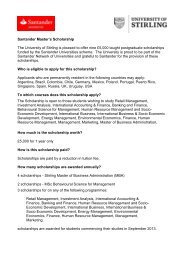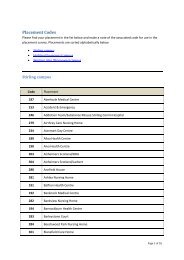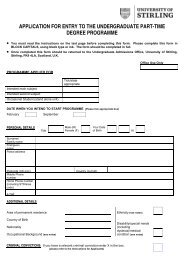Health First: An evidence-based alcohol strategy for the UK
Health First: An evidence-based alcohol strategy for the UK
Health First: An evidence-based alcohol strategy for the UK
You also want an ePaper? Increase the reach of your titles
YUMPU automatically turns print PDFs into web optimized ePapers that Google loves.
<strong>Health</strong> <strong>First</strong>: an <strong>evidence</strong>-<strong>based</strong> <strong>alcohol</strong> <strong>strategy</strong> <strong>for</strong> <strong>the</strong> <strong>UK</strong><br />
Recommendations<br />
The sale of <strong>alcohol</strong> products that appeal<br />
more to children and young people than<br />
to adults should be prohibited.<br />
<strong>An</strong> independent body should be<br />
established to regulate <strong>alcohol</strong><br />
promotion, including product and<br />
packaging design, in <strong>the</strong> interests of<br />
public health and community safety.<br />
Product labels<br />
<strong>Health</strong> warnings are now a familiar and prominent<br />
feature on all tobacco products. Likewise, detailed<br />
nutritional labelling is ubiquitous on food products<br />
and soft drinks. Yet <strong>the</strong> consumer in<strong>for</strong>mation on<br />
<strong>alcohol</strong> products usually extends no fur<strong>the</strong>r than a<br />
figure describing <strong>the</strong> strength of <strong>the</strong> <strong>alcohol</strong> content.<br />
Despite <strong>the</strong>ir substantial impact on both health and<br />
nutrition, many <strong>alcohol</strong> products are labelled with<br />
minimal regard <strong>for</strong> ei<strong>the</strong>r. The producer has a free<br />
hand to exploit <strong>the</strong> label to promote <strong>the</strong> brand.<br />
From a consumer perspective, this is an extraordinary<br />
anomaly. The objective of food labelling is to support<br />
consumers in making in<strong>for</strong>med decisions about<br />
what <strong>the</strong>y eat and drink. The absence of meaningful<br />
in<strong>for</strong>mation on <strong>alcohol</strong> products leaves consumers<br />
unin<strong>for</strong>med about one of <strong>the</strong> most harmful products<br />
<strong>the</strong>y purchase.<br />
There is <strong>evidence</strong> that <strong>the</strong> inclusion of health warnings<br />
on <strong>alcohol</strong> products increases consumers’ knowledge<br />
and awareness of <strong>the</strong> adverse health impacts of<br />
behaviour supports <strong>the</strong> case <strong>for</strong> change 6 , as does <strong>the</strong><br />
wider literature on <strong>the</strong> impact of product warnings 7 .<br />
In order to be effective in in<strong>for</strong>ming <strong>the</strong> consumer about<br />
his or her risk, <strong>the</strong> labelling of <strong>alcohol</strong> products ought<br />
to include salient health warnings and unit in<strong>for</strong>mation<br />
alongside nutritional and calorie in<strong>for</strong>mation. The<br />
inclusion of unit in<strong>for</strong>mation would help to address<br />
<strong>the</strong> low level of understanding of <strong>alcohol</strong> units among<br />
drinkers 7 . <strong>Health</strong> warnings should be varied to address<br />
<strong>the</strong> many potential harms to health of drinking.<br />
Recommendations<br />
At least one third of every <strong>alcohol</strong><br />
product label should be given over to an<br />
<strong>evidence</strong>-<strong>based</strong> health warning specified<br />
by an independent regulatory body.<br />
Every <strong>alcohol</strong> product label should<br />
describe, in legible type, <strong>the</strong> product’s<br />
nutritional, calorie and <strong>alcohol</strong> content.<br />
There is also considerable scope to communicate<br />
unit in<strong>for</strong>mation in o<strong>the</strong>r settings. In pubs and bars,<br />
unit in<strong>for</strong>mation ought to be displayed prominently<br />
at <strong>the</strong> point of sale. Likewise when <strong>alcohol</strong> is sold in<br />
supermarkets, <strong>the</strong> till receipts ought to show <strong>the</strong><br />
number of units of <strong>alcohol</strong> purchased. Customer loyalty<br />
card data could also be used to in<strong>for</strong>m customers about<br />
how many units of <strong>alcohol</strong> <strong>the</strong>y have bought.<br />
Consumers need a framework of risk within which to<br />
make sense of in<strong>for</strong>mation about how much <strong>alcohol</strong><br />
<strong>the</strong>y are consuming. Existing governmental guidelines<br />
are <strong>based</strong> on a report by <strong>the</strong> Royal College of Physicians<br />
in 1987 9 , subsequently revised upwards in 1995<br />
despite a lack of <strong>evidence</strong> <strong>for</strong> <strong>the</strong> change 10 . The revised<br />
The absence of meaningful in<strong>for</strong>mation on <strong>alcohol</strong><br />
products leaves consumers unin<strong>for</strong>med about one<br />
of <strong>the</strong> most harmful products <strong>the</strong>y purchase<br />
<strong>alcohol</strong> 4,5 . Evidence of <strong>the</strong> impact of warnings on actual<br />
drinking behaviour is more equivocal: improvements<br />
in in<strong>for</strong>mation and knowledge may not be sufficient to<br />
trigger action but <strong>the</strong>y provide a necessary foundation<br />
<strong>for</strong> action. However, <strong>the</strong> <strong>evidence</strong> of <strong>the</strong> impact<br />
of tobacco product health warnings on smoking<br />
guidelines have been criticised as promoting levels of<br />
<strong>alcohol</strong> consumption above a ‘low risk’ threshold 11 .<br />
The Chief Medical Officer’s current review of <strong>the</strong>se<br />
guidelines is a prerequisite <strong>for</strong> <strong>the</strong> introduction of<br />
health warnings and unit in<strong>for</strong>mation on <strong>alcohol</strong><br />
products.<br />
23
















